CJ2M-CPU3[] / CPU1[] / MD21[]
CJ-series CJ2M CPU Units, Pulse I/O Modules
![CJ2M-CPU3[] / CPU1[] / MD21[]](/Images/l_2712-19-118595-198x198.jpg)
Since 2001, CJ1M-series PLCs are in control of a wide variety of applications worldwide. The accumulated experience and advancements in technology now result in CJ2M; fully compatible, yet fully new.
- Features
- Lineup
- Specifications
- Dimensions
- Catalog / Manual / CAD / Software
last update: October 1, 2024
General Specifications
| Item | CJ2M- | ||
|---|---|---|---|
| CPU1[] | CPU3[] | ||
| Enclosure | Mounted in a panel | ||
| Grounding | Less than 100 Ω | ||
| CPU Unit Dimensions | 90 mm × 75 mm × 31 mm | 90 mm × 75 mm × 62 mm | |
| Weight (see note 2) | 130 g or less | 190 g or less (see note 1) | |
| Current Consumption | 5 VDC, 0.5 A | 5 VDC, 0.7 A | |
| Operation
Environment |
Ambient Operating Temperature | 0 to 55 °C | |
| Ambient Operating Humidity | 10% to 90% (with no condensation) | ||
| Atmosphere | Must be free from corrosive gases. | ||
| Ambient Storage Temperature | - 20 to 70 °C (excluding battery) | ||
| Altitude | 2,000 m or less | ||
| Pollution Degree | 2 or less: Meets IEC 61010-2-201. | ||
| Noise Immunity | 2 kV on power supply line (Conforms to IEC 61000-4-4.) | ||
| Overvoltage Category | Category II: Meets IEC 61010-2-201. | ||
| EMC Immunity Level | Zone B | ||
| Vibration Resistance | Conforms to IEC60068-2-6
5 to 8.4 Hz with 3.5-mm amplitude, 8.4 to 150 Hz Acceleration of 9.8 m/s2 for 100 min in X, Y, and Z directions (10 sweeps of 10 min each = 100 min total) |
||
| Shock Resistance | Conforms to IEC60068-2-27
147 m/s2, 3 times in X, Y, and Z directions (100 m/s2 for Relay Output Units) |
||
| Battery | Life | 5 years at 25 °C | |
| Weight | Approx. 10 g | ||
| Model | CJ1W-BAT01 | ||
| Applicable Standards | Conforms to cULus, NK, LR, and EC Directives. | ||
Note:1. Without a Serial Option Board.
2. Includes wight of end covers and battery.
Performance Specifications
| Items | CJ2M- | ||||||||
|---|---|---|---|---|---|---|---|---|---|
| CPU11/31 | CPU12/32 | CPU13/33 | CPU14/34 | CPU15/35 | |||||
| User Memory | 5K steps | 10K steps | 20K steps | 30K steps | 60K steps | ||||
| I/O Bits | 2,560 bits | ||||||||
| Proc-
essing Speed |
Overhead Processing Time | Normal Mode:
CJ2M-CPU3[]: 270 μs * CJ2M-CPU1[]: 160 μs * * The following time must be added when using EtherNet/IP tag data links for the CJ2M-CPU3[]. 100 μs + (Number of words transferred × 1.8 μs) The following time must be added when using Pulse I/O Modules with a CJ2M CPU Unit: 10 μs × Number of Pulse I/O Modules |
|||||||
| Execution Time | Basic Instructions: 0.04 μs min.
Special Instructions: 0.06 μs min. |
||||||||
| Inter-
rupts |
I/O Interrupts and External
Interrupts |
Interrupt task startup time: 31 μs
Return time to cyclic task: 10 μs |
|||||||
| Scheduled Interrupts | Minimum time interval: 0.4 ms (set in 0.1 ms increments) | ||||||||
| Interrupt task startup time: 30 μs
Return time to cyclic task: 11 μs |
|||||||||
| Maximum Number of Connectable Units | Total per CPU Rack or Expansion Rack: 10 Units max.;
Total per PLC: 40 Units max. |
||||||||
| Basic I/O Units | No limit
However, a maximum of two CJ1W-INT01 Interrupt Input Units can be mounted. |
||||||||
| Special I/O Units | Units for up to 96 unit numbers can be mounted. (Unit numbers run from 0 to 95. Units are allocated between 1 and 8 unit numbers.) | ||||||||
| CPU Bus Units | CJ2M-CPU3[]: 15 Units max.
CJ2M-CPU1[]: 16 Units max. |
||||||||
| Pulse I/O Modules | 2 Units max. *
* Supported only by CJ2M CPU Units with unit version 2.0 or later. A Pulse I/O Module must be mounted. |
||||||||
| Slots for which interrupts can be used | Slots 0 to 4 on CPU Rack | ||||||||
| Maximum Number of Expansion Racks | 3 max. | ||||||||
| CIO Area | I/O Area | 2,560 bits (160 words): Words CIO 0000 to CIO 0159 | |||||||
| Link Area | 3,200 bits (200 words): Words CIO 1000 to CIO 1199 | ||||||||
| CPU Bus Unit Area | 6,400 bits (400 words): Words CIO 1500 to CIO 1899 | ||||||||
| Special I/O Unit Area | 15,360 bits (960 words): Words CIO 2000 to CIO 2959 | ||||||||
| Pulse I/O Area | 20 inputs, 12 outputs (CIO 2960 to CIO 2963) *
* Supported only by CJ2M CPU Units with unit version 2.0 or later. A Pulse I/O Module must be mounted. |
||||||||
| Serial PLC Link Words | 1,440 bits (90 words): Words CIO 3100 to CIO 3189 | ||||||||
| DeviceNet Area | 9,600 bits (600 words): Words CIO 3200 to CIO 3799 | ||||||||
| Internal I/O Area | 3,200 bits (200 words): Words CIO 1300 to CIO 1499 (Cannot be used for external I/O.)
37,504 bits (2,344 words): Words CIO 3800 to CIO 6143 (Cannot be used for external I/O.) |
||||||||
| Work Area | 8,192 bits (512 words): Words W000 to W511 (Cannot be used for external I/O.) | ||||||||
| Holding Area | 8,192 bits (512 words): Words H000 to H511
Bits in this area maintain their ON/OFF status when PLC is turned OFF or operating mode is changed. Words H512 to H1535: These words can be used only for function blocks. They can be used only for function block instances (i.e., they are allocated only for internal variables in function blocks). |
||||||||
| Auxiliary Area | Read-only: 31,744 bits (1,984 words)
7,168 bits (448 words): Words A0 to A447 24,576 bits (1,536 words): Words A10000 to A11535 * Read/write: 16,384 bits (1,024 words) in words A448 to A1471 * * A960 to A1471 and A10000 to A11535 cannot be accessed by CPU Bus Units, Special I/O Units, PTs, and Support Software that do not specifically support the CJ2 CPU Units. |
||||||||
| Temporary Area | 16 bits: TR0 to TR15 | ||||||||
| Timer Area | 4,096 timer numbers (T0000 to T4095 (separate from counters)) | ||||||||
| Counter Area | 4,096 counter numbers (C0000 to C4095 (separate from timers)) | ||||||||
| DM Area | 32k words *
DM Area words for Special I/O Units: D20000 to D29599 (100 words × 96 Units) DM Area words for CPU Bus Units: D30000 to D31599 (100 words × 16 Units) * Bits in the EM Area can be addressed either by bit or by word. These bits cannot be addressed by CPU Bus Units, Special I/O Units, PTs, and Support Software that do not specifically support the CJ2 CPU Units. |
||||||||
| EM Area | 32k words/bank × 4 banks max.: E00_00000 to E3_32767 max. *
* Bits in the EM Area can be addressed either by bit or by word. These bits cannot be addressed by CPU Bus Units, Special I/O Units, PTs, and Support Software that do not specifically support the CJ2 CPU Units. |
||||||||
| 32K words × 1 bank | 32K words × 4 banks | ||||||||
| Force-S/R Enabled Banks *1 | Bank 0 hex | Bank 0 to 3 hex | |||||||
| Index Registers | IR0 to IR15
These are special registers for storing PLC memory addresses for indirect addressing. (Index Registers can be set so that they are unique in each task or so that they are shared by all tasks.) |
||||||||
| Cyclic Task Flag Area | 128 flags | ||||||||
| Memory Card | 128 MB, 256 MB, or 512 MB | ||||||||
| Operating Modes | PROGRAM Mode: Programs are not executed. Preparations can be executed prior to program execution in this mode.
MONITOR Mode: Programs are executed, and some operations, such as online editing, and changes to present values in I/O memory, are enabled in this mode. RUN Mode: Programs are executed. This is the normal operating mode. |
||||||||
| Execution Mode | Normal Mode | ||||||||
| Programming Languages | Ladder Logic (LD),
Sequential Function Charts (SFC), Structured Text (ST), and Instruction Lists (IL) |
||||||||
| Function
Blocks |
Maximum number of definitions | 256 | 2,048 | ||||||
| Maximum number of instances | 256 | 2,048 | |||||||
| FB Program Area | 20K steps | ||||||||
| Tasks | Type of Tasks | Cyclic tasks
Interrupt tasks (Power OFF interrupt tasks, scheduled interrupt tasks, I/O interrupt tasks, and external interrupt tasks, and input interrupt tasks *2) |
|||||||
| Number of Tasks | Cyclic tasks: 128
Interrupt tasks: 256 (Interrupt tasks can be defined as cyclic tasks to create extra cyclic tasks. Therefore, the total number of cyclic tasks is actually 384 max.) |
||||||||
| Symbols
(Varia- bles) |
Type of Symbols | Local symbols: Can be used only within a single task in the PLC.
Global symbols: Can be used in all tasks in the PLC. Network symbols (tags) *: I/O memory in the CPU Unit can be externally accessed using symbols, depending on parameter settings. * Supported only by the CJ2M-CPU3[]. |
|||||||
| Data Type of Symbols | BOOL (bit)
UINT (one-word unsigned binary) UDINT (two-word unsigned binary) ULINT (four-word unsigned binary) INT (one-word signed binary) DINT (two-word signed binary) LINT (four-word signed binary) UINT BCD (one-word unsigned BCD) *3 UDINT BCD (two-word unsigned BCD) *3 ULINT BCD (four-word unsigned BCD) *3 REAL (two-word floating-point) LREAL (four-word floating-point) CHANNEL (word) *3 NUMBER (constant or number) *3 WORD (one-word hexadecimal) DWORD (two-word hexadecimal) LWORD (four-word hexadecimal) STRING (1 to 255 ASCII characters) TIMER (timer) *4 COUNTER (counter) *4 User defined data types (data structures) |
||||||||
| Maximum Size of Symbol | 32k words | ||||||||
| Array Symbols (Array Variables) | One-dimensional arrays | ||||||||
| Number of Array Elements | 32,000 elements max. | ||||||||
| Number of Registrable Network Symbols (Tags) *5 | 2,000 max. | ||||||||
| Length of Network Symbol (Tag) Name
*5 |
255 bytes max. | ||||||||
| Encoding of Network Symbols (Tags)
*5 |
UTF-8 | ||||||||
| Data
Tracing |
Memory Capacity | 8,000 words
(The EM Area can be specified from the CX-Programmer to use up to 32K words multiplied by the number of banks supported by the CPU Unit model.) |
|||||||
| Number of Samplings | Bits = 31, one-word data =16, two-word data = 8, four-word data = 4 | ||||||||
| Sampling Cycle | 1 to 2,550 ms (Unit: 1 ms) | ||||||||
| Trigger Conditions | ON/OFF of specified bit
Data comparison of specified word Data size: 1 word, 2 words, 4 words Comparison Method: Equals (=), Greater Than (>), Greater Than or Equals (≥), Less Than (<), Less Than or Equals (≤), Not Equal (≠) |
||||||||
| Delay Value | - 32,768 to +32,767 ms | ||||||||
| File Memory | Memory Card (128, 256, or 512 Mbytes) (Use the Memory Cards provided by OMRON.)
EM file memory (Part of the EM Area can be converted for use as file memory.) |
||||||||
| Source/
Comment Memory |
Function block program memory, comment file, program index file, symbol tables | Capacity: 1 Mbytes | |||||||
| Commu-
nications |
Logical Ports for
Communications |
Logical Ports | 8 ports (Used for SEND, RECV, CMND, PMCR, TXDU, and RXDU instructions.) | ||||||
| Extended Logical
Ports |
64 ports (Used for SEND2, RECV2, CMND2, and PMCR2 instructions.) | ||||||||
| CIP
Communications Specification |
Class 3
(Connection Type) |
Number of connections: 128 | |||||||
| UCMM (Non-
connection Type) |
Maximum number of clients that can communicate at the same time: 16
Maximum number of servers that can communicate at the same time: 16 |
||||||||
| Peripheral (USB) Port | USB 2.0-compliant B-type connector | ||||||||
| Baud Rate | 12 Mbps max. | ||||||||
| Transmission Distance | 5 m max. | ||||||||
| Serial Port | CJ2M-CPU1[] interface: Conforms to EIA RS-232C.
CJ2M-CPU3[]: No serial ports with default system One of the following Serial Option Boards can be mounted. CP1W-CIF01 RS-232C Option Board CP1W-CIF11 RS-422A/485 Option Board (not isolated, max. transmission distance: 50 m) CP1W-CIF12-V1 RS-422A/485 Option Board (isolated, max. transmission distance: 500 m) |
||||||||
| Communications Method | Half-duplex | ||||||||
| Synchronization Method | Start-stop | ||||||||
| Baud Rate | 0.3, 0.6, 1.2, 2.4, 4.8, 9.6, 19.2, 38.4, 57.6, or 115.2 (kbps) | ||||||||
| Transmission Distance | 15 m max. | ||||||||
| EtherNet/IP Port *6 | - | ||||||||
| Trans-
mission Specifi- cations |
Media Access
Method |
CSMA/CD | |||||||
| Modulation | Baseband | ||||||||
| Transmission Paths | Star | ||||||||
| Baud Rate | 100 Mbps (100Base-TX) | ||||||||
| Transmission
Media |
Shielded twisted-pair (STP) cable; Categories: 5, 5e | ||||||||
| Transmission
Distance |
100 m (between ethernet switch and node) | ||||||||
| Number of Cascade
Connections |
No restrictions if ethernet switch is used. | ||||||||
| Commu-
nications Specifi- cations |
CIP
Communications: Tag Data Links |
||||||||
| Number of
Connections |
32 | ||||||||
| Packet Interval
(Refresh period) |
1 to 10,000 ms (Unit: 0.5 ms)
Can be set for each connection. (Data will be refreshed at the set interval, regardless of the number of nodes.) |
||||||||
| Permissible
Communications Band |
3,000 packets per second *7 | ||||||||
| Number of
Registerable Tag |
32 | ||||||||
| Type of Tags | CIO, DM, EM, HR, WR, and Network symboles | ||||||||
| Number of Tags
per Connection |
8 (Seven tags if PLC status is included in the segment.) | ||||||||
| Maximum Link
Data Size per Node (total size of all tags) |
640 words | ||||||||
| Maximum Data
Size per Connection |
640 words *8 (Data is synchronized within each connection.) | ||||||||
| Number of
Registrable Tag Set |
32 (1 connection = 1 segment) | ||||||||
| Maximum Tag
Set Size |
640 words *8 (One word is used when PLC status is included in the segment.) | ||||||||
| Maximum
Number of Tags Refreshable in a Single Cycle of CPU Unit *9 |
Output/send (CPU Unit to EtherNet/IP): 32
Input/receive (EtherNet/IP to CPU Unit): 32 |
||||||||
| Data Size
Refreshable in a Single Cycle of CPU Unit *9 |
Output/send (CPU to EtherNet/IP): 640 words
Input/receive (EtherNet/IP to CPU): 640 words |
||||||||
| Change of Tag
Data Link Parameter Settings during Operation |
OK *10 | ||||||||
| Multi-cast Packet
Filter *11 |
OK | ||||||||
| CIP
Communications: Explicit Messages |
- | ||||||||
| Class 3
(Connection Type) |
Number of connections: 128 | ||||||||
| UCMM (Non-
connection Type) |
Maximum number of clients that can communicate at the same time: 16
Maximum number of servers that can communicate at the same time: 16 |
||||||||
| CIP Routing | OK(CIP routing is enabled for the following remote Units: CJ1W-EIP21/EIP21S, CJ2H-CPU6[]-EIP,CJ2M-CPU3[], and CS1W-EIP21/EIP21S.) | ||||||||
| FINS
Communications |
- | ||||||||
| FINS/UDP | OK | ||||||||
| FINS/TCP | 16 connections max. | ||||||||
| EtherNet/IP
Conformance Test |
Conforms to A5. | ||||||||
| EtherNet/IP
Interface |
10Base-T/100Base-TX
Auto Negotiation/Fixed Setting |
||||||||
*1. Force-setting/resetting bits in the EM Area is possible only for banks specified for the EM Area force-set/reset function.
*2. Supported only by CJ2M CPU Units with unit version 2.0 or later. A Pulse I/O Module must be mounted.
*3. Cannot be used in Function blocks.
*4. Can be used only in Function blocks.
*5. Supported only by the CJ2M-CPU3[].
*6. The EtherNet/IP port is built into CJ2M-CPU3[] only.
*7. "Packets per second" is the number of communications packets that can be processed per second.
*8. Unit version 2.0 of built-in EtherNet/IP section: 20 words.
*9. If the maximum number is exceeded, refreshing will require more than one CPU Unit cycle.
*10.When changing parameters, however, the EtherNet/IP port where the change is made will be restarted. In addition, a
timeout will temporarily occur at the other node that was communicating with that port, and it will then recover
automatically.
*11.The EtherNet/IP port supports an IGMP client, so unnecessary multicast packets are filtered by using an Ethernet
switch that supports IGMP snooping.
Function Specifications
| Functions | Description | |||
|---|---|---|---|---|
| Cycle
Time Man- agement |
Minimum Cycle Time | A minimum cycle time can be set.
(0.2 to 32,000 ms; Unit: 0.1 ms) The minimum cycle time setting can be changed in MONITOR mode. |
||
| Cycle Time Monitoring | The cycle time is monitored.
(0.01 to 40,000 ms; Unit: 0.01 ms) |
|||
| Background Processing | Instructions with long execution times can be executed over multiple cycles to prevent fluctuations in the cycle time. | |||
| Unit
(I/O) Man- agement |
Basic I/O
Units, Special I/O Units, and CPU Bus Units |
I/O
Refreshing |
Cyclic
Refreshing |
Cyclic refreshing of Basic I/O Units, Special I/O Units, and CPU Bus Units |
| Immediate
Refreshing |
I/O refreshing by immediate refreshing instructions | |||
| Refreshing
by IORF |
I/O refreshing by IORF instruction | |||
| Unit Recognition at Startup | The number of units recognized when the power is turned ON is displayed. | |||
| Basic I/O
Units |
Input Response Time Setting | The input response times can be set for Basic I/O Units. The response time can be increased to reduce the effects of chattering and noise at input contacts. The response time can be decreased to enable detecting shorter input pulses. | ||
| Load OFF Function | All of the outputs on Basic I/O Units can be turned OFF when an error occurs in RUN or MONITOR mode. | |||
| Basic I/O Unit Status Monitoring | Alarm information can be read from Basic I/O Units and the number of Units recognized can be read. | |||
| Reading/writing data using instructions for specific Units | Special instructions can be used to read/write required data for specific Units at high speed. | |||
| Special I/O
Units and CPU Bus Units |
Unit Restart Bits to Restart Units | A Special I/O Unit or CPU Bus Unit can be restarted. | ||
| Config-
uration Man- agement |
Automatic I/O Allocation at Startup | I/O words can be automatically allocated to the Basic I/O Units that are connected in the PLC to start operation automatically without registering Units into I/O tables. | ||
| I/O Table Creation | The current unit configuration can be registered in I/O tables to prevent it from being changed, to reserve words, and to set words. | |||
| Rack/Slot First Word Settings | The first words allocated to a Units on the Racks can be set. | |||
| Memory
Man- agement |
Holding I/O Memory when Changing Operating Modes | The status of I/O memory can be held when the operating mode is changed or power is turned ON. The forced-set/reset status can be held when the operating mode is changed or power is turned ON. | ||
| File Memory | Files (such as program files, data files, and symbol table files) can be stored in Memory Card, EM File Memory, or Comment Memory. | |||
| Built-in Flash Memory | The user program and Parameter Area can be backed up to an internal flash memory when they are transferred to the CPU Unit. | |||
| EM File Function | Parts of the EM Area can be treated as file memory. | |||
| Storing Comments | I/O comments can be stored as symbol table files in a Memory Card, EM file memory, or comment memory. | |||
| EM Configuration | EM Area can be set as trace memory or EM file memory. | |||
| Memory
Cards |
Automatic File Transfer at Startup | A program file and parameter files can be read from a Memory Card when the power is turned ON. | ||
| Program Replacement during PLC Operation | User programs can be transferred from a Memory Card to CPU Unit during operation. | |||
| Function for Reading and Writing Data from a Memory Card | Data in I/O memory in the CPU Unit can be written to a Memory Card in CSV/TXT format. Data in CSV/TXT format in the Memory Card can be read to I/O memory in the CPU Unit. | |||
| Communications | - | |||
| Peripheral (USB) Port | Peripheral Bus | Bus for communications with various kinds of Support Software running on a personal computer. High-speed communications are supported. | ||
| Serial Port (Option) *12 | Application is possible when a Serial Communications Option Board is mounted. | |||
| Host Link (SYSWAY) Communications | Host Link commands or FINS commands placed between Host Link headers and terminators can be sent from a host computer or PT to read/write I/O memory, read/control the operating mode, and perform other operations for PLC. | |||
| No-protocol Communications | I/O instructions for communications ports (such as TXD/RXD instructions) can be used for data transfer with peripheral devices such as bar code readers and printers. | |||
| NT Link Communications | I/O memory in the PLC can be allocated and directly linked to various PT functions, including status control areas, status notification areas, touch switches, lamps, memory tables, and other objects. | |||
| Peripheral Bus | Bus for communications with various kinds of Support Software running on a personal computer. High-speed communications are supported. | |||
| Serial Gateway | This gateway enables receiving and automatically converting FINS to the CompoWay/F. | |||
| Serial PLC Links | Data is exchanged between CPU Units using serial ports without communications programming. PTs set to the 1:N NT Link protocol can be included in the network. | |||
| EtherNet/IP Port *13 | 100Base-TX/10Base-T
Protocols: TCP/IP, UDP, ARP, ICMP (ping only), BOOTP Applications: FINS, CIP, SNTP, DNS (Client), FTP (Server) |
|||
| CIP
Commun- ications Service |
Tag Data Links | Programless cyclic data exchanges with the devices on the EtherNet/IP network. | ||
| Message
Communications |
Any CIP commands can be received from the devices on the EtherNet/IP network. | |||
| FINS
Commun- ications Service |
Message
Communications |
Any FINS commands can be transferred with the devices on the EtherNet/IP network. | ||
| Interrupt | Scheduled Interrupts | Tasks can be executed at a specified interval (minimum of 0.2 ms, Unit: 0.1 ms). | ||
| Resetting and restarting with MSKS (690) | When MSKS(690) is executed, the internal timer is restarted and the time to first interrupt is set to a fixed value. | |||
| Reading present value of internal timer with MSKS (690) | MSKS(690) can be used to read the time that has elapsed until the schedule interrupt is started or since the previous scheduled interrupt. | |||
| Power OFF Interrupts | A task can be executed when CPU Unit's power turns OFF. | |||
| I/O Interrupt Tasks | A task can be executed when an input signal is input to an Interrupt Input Unit. | |||
| External Interrupt Tasks | A task can be executed when interrupts are requested from a Special I/O Unit or a CPU Bus Unit. | |||
| Clock | Clock Function | Clock data is stored in memory.
Accuracy (Accuracy depends on the temperature.) Ambient temperature of 55 °C: - 3.5 to +0.5 min error per month Ambient temperature of 25 °C: - 1.5 to +1.5 min error per month Ambient temperature of 0 °C: - 3 to +1 min error per month |
||
| Operation Start Time Storage | The time when operating mode was last changed to RUN mode or MONITOR mode is stored. | |||
| Operation Stop Time Storage | The last time a fatal error occurred or the last time the operating mode was changed to PROGRAM mode is stored. | |||
| Startup Time Storage | The time when the power was turned ON is stored. | |||
| Power Interruption Time Storage | The time when the power is turned OFF is stored. | |||
| Total Power ON Time Calculation | The total time that the PLC has been ON is stored in increments of 10 hours. | |||
| Power ON Clock Data Storage | A history of the times when the power was turned ON is stored. | |||
| User Program Overwritten Time Storage | The time that the user program was last overwritten is stored. | |||
| Parameter Date Storage | The time when the Parameter Area was overwritten is stored. | |||
| Power
Supply Man- agement |
Memory Protection | Holding Area data, DM Area data, EM Area data, Counter Completion Flags, and counter present values are held even when power is turned OFF. CIO Area, Work Area, some Auxiliary Area data, and Timer Completion Flags, timer present values, index registers, and data registers can be protected by turning ON the IOM Hold Bit in the Auxiliary Area, and by also setting the IOM Hold Bit to "Hold" in the PLC Setup. | ||
| Power OFF Detection Time Setting | The detection time for power interruptions can be set.
AC power supply: 10 to 25 ms (variable) DC power supply: 2 to 5 ms (CJ1W-PD022) or 2 to 20 ms (CJ1W-PD025) |
|||
| Power OFF Detection Delay Time | The detection of power interruptions can be delayed: 0 to 10 ms
(Not supported by the CJ1W-PD022.) |
|||
| Number of Power Interruptions Counter | The number of times power has been interrupted is counted. | |||
| Function Blocks | Standard programming can be encapsulated as function blocks. | |||
| Languages in Function Block Definitions | Ladder programming or structured text | |||
| De-
bugging |
Online Editing | The program can be changed during operation (in MONITOR or PROGRAM mode), except for block programming areas. | ||
| Force-Set/Reset | Specified bits can be set or reset.
Force-set/reset to the EM Area is enabled by specifying a start bank in parameter setting. |
|||
| Differentiate Monitoring | ON/OFF changes in specified bits can be monitored. | |||
| Data Tracing | The specified I/O memory data can be stored in the trace memory in the CPU Unit. The triggers can be set. | |||
| Continuous Tracing | The trace data can be uploaded during data tracing using CX-Programmer, which enables continuously logging the data by constantly uploading the trace data. | |||
| Automatically starting tracing when operation starts | Data tracing can be automatically started when operation is started (i.e., when the operating mode is changed from PROGRAM mode to MONITOR or RUN mode). | |||
| Storing Location of Error when an Error Occurs | The location and task number where execution stopped for a program error is recorded. | |||
| Program Check | The programs can be checked for items such as no END instruction and FALS/FAL errors at startup. | |||
| Self-
diagnosis and Res- toration |
Error Log | A function is provided to store predefined error codes in CPU Unit, error information, and time at which the error occurred. | ||
| CPU Error Detection | CPU Unit WDT errors are detected. | |||
| User-defined Failure Diagnosis | Errors can be generated for user-specified conditions: Non-fatal errors (FAL) and fatal errors (FALS).
Program section time diagnosis and program section logic diagnosis are supported (FPD instruction). |
|||
| Load OFF Function | This function turns OFF all outputs from Output Units when an error occurs. | |||
| RUN Output | The RUN output from the CJ1W-PA205R turns ON while CPU Unit is in RUN mode or MONITOR mode. | |||
| Basic I/O Load Short-circuit Detection | This function provides alarm information from Basic I/O Units that have load short-circuit protection. | |||
| Failure Point Detection | The time and logic of an instruction block can be analyzes using the FPD instruction. | |||
| CPU Standby Detection | This function indicates when the CPU Unit is on standby because all Special I/O Units and CPU Bus Units have not been recognized at the startup in RUN or MONITOR mode. | |||
| Non-fatal
Error Detection |
System FAL Error Detection (User-defined non-fatal error) | This function generates a non-fatal (FAL) error when the user-defined conditions are met in program. | ||
| Duplicate Refreshing Error Detection | This function detects an error when an immediate refreshing Instruction in an interrupt task is competing with I/O refreshing of a cyclic task. | |||
| Basic I/O Unit Error Detection | This function detects the errors in Basic I/O Units. | |||
| Backup Memory Error Detection | This function detects errors in the memory backup of the user programs and parameter area (backup memory). | |||
| PLC Setup Error Detection | This function detects setting errors in the PLC Setup. | |||
| CPU Bus Unit Error Detection | This function detects an error when there is an error in data exchange between the CPU Unit and a CPU Bus Unit. | |||
| Special I/O Unit Error Detection | This function detects an error when there is an error in data exchange between the CPU Unit and a Special I/O Unit. | |||
| Tag Memory Error Detection *13 | This function detects errors in tag memory. | |||
| Battery Error Detection | This function detects an error when a battery is not connected to the CPU Unit or when the battery voltage drops. | |||
| CPU Bus Unit Setting Error Detection | This function detects an error when the model of a CPU Bus Unit in the registered I/O tables does not agree with the model that is actually mounted in the PLC. | |||
| Special I/O Unit Setting Error Detection | This function detects an error when the model of a Special I/O Unit in the registered I/O tables does not agree with the model of Unit that is actually mounted. | |||
| Option Board Error Detection *13 | This function detects the errors in Serial Option Board mounting status. | |||
| Fatal
Error Detection |
Memory Error Detection | This function detects errors that occur in memory of the CPU Unit. | ||
| I/O Bus Error Detection | This function detects when an error occurs in data transfers between the Units mounted in Rack slots and the CPU Unit and detects when the End Cover is not connected to the CPU Rack or an Expansion Rack. | |||
| Unit/Rack Number Duplication Error | This function detects an error when the same unit number is set for two or more Units, the same word is allocated to two or more Basic I/O Units, or the same rack number is set for two or more Racks. | |||
| Too Many I/O Points Error Detection | This function detects an error when the total number of I/O points set in the I/O tables or the number of Units per Rack exceeds the specified range. | |||
| I/O Setting Error Detection | This function detects an error when the number of Units in the registered I/O tables does not agree with the actual number of Units that is mounted, or an Interrupt Unit has been connected in the wrong position, i.e., not in slot 0 to 4. | |||
| Program Error Detection | This function detects errors in programs. | |||
| Instruction
Processing Error Detection |
This function detects an error when the given data value is invalid when executing an instruction, or execution of instruction between tasks was attempted. | |||
| Indirect DM/EM
BCD Error Detection |
This function detects an error when an indirect DM/EM address in BCD mode is not BCD. | |||
| Illegal Area
Access Error Detection |
This function detects an error when an attempt is made to access an illegal area with an instruction operand. | |||
| No END Error
Detection |
This function detects an error when there is no END instruction at the end of the program. | |||
| Task Error
Detection |
This function detects an error when there are no tasks that can be executed in a cycle, there is no program for a task, or the execution condition for an interrupt task was met but there is no interrupt task with the specified number. | |||
| Differentiation
Overflow Error Detection |
This function detects an error when too many differentiated instructions are entered or deleted during online editing (131,072 times or more). | |||
| Invalid
Instruction Error Detection |
This function detects an error when an attempt is made to execute an instruction that is not defined in the system. | |||
| User Program
Area Overflow Error Detection |
This function detects an error when instruction data is stored after the last address in user program area. | |||
| Cycle Time Exceeded Error Detection | This function monitors the cycle time (10 to 40,000 ms) and stops the operation when the set value is exceeded. | |||
| System FALS Error Detection (User-defined Fatal Error) | This function generates a fatal (FALS) error when the user-defined conditions are met in program. | |||
| Version Error Detection | This function detects an error when a user program includes a function that is not supported by the current unit version. | |||
| Memory Card Transfer Error Detection | This function detects an error when the automatic file transfer from Memory Card fails at startup. | |||
| Main-
tenance |
Simple Backup Function | This function collectively backs up the data in CPU Unit (user programs, parameters, and I/O memory) and internal backup data in the I/O Units. | ||
| Unsolicited Communications | A function that allows the PLC to use Network Communications Instruction to send required FINS commands to a computer connected via a Host Link | |||
| Remote Programming and Monitoring | Host Link communications can be used for remote programming and remote monitoring through a Controller Link, Ethernet, DeviceNet, or SYSMAC LINK Network. Communications across network layers can be performed.
Controller Link or Ethernet: 8 layers DeviceNet or SYSMAC LINK: 3 layers |
|||
| Automatic Online Connection via Network | Direct Serial
Connection |
This function enables automatically connecting to the PLC online when the CX-Programmer is directly connected by a serial connection (peripheral (USB) port or serial port). | ||
| Via Networks | This function enables connecting the CX-Programmer online to a PLC that is connected via an EtherNet/IP network. | |||
| Security | Read Protection using Password | This function protects reading and displaying programs and tasks using passwords.
Write protection: Set using the DIP switch. Read protection: Set a password using the CX-Programmer. |
||
| FINS Write Protection | This function prohibits writing by using FINS commands sent over the network. | |||
| Unit Name Function | This function allows the users to give any names to the Units. Names are verified at online connection to prevent wrong connection | |||
| Hardware ID Using Lot Numbers | This function sets operation protection by identifying hardware using the user programs according to lot numbers stored in the Auxiliary Area. | |||
*13. Supported only by the CJ2M-CPU3[].
Pulse I/O Functions
The following functions of CJ2M can be used by installing one or two Pulse I/O Modules. Each module has 10 high-speed inputs and 6 high-speed outputs. Pulse I/O Modules can be installed on CJ2M CPU Units with Unit Version 2.0 or Later.
- The inputs can be used as general-purpose inputs, interrupt inputs, quick-response inputs, high-speed counters, or origin search inputs.
- The outputs can be used as general-purpose outputs, pulse outputs, origin search outputs, or PWM outputs.
One Pulse I/O Module can be mounted
![CJ2M-CPU3[] / CPU1[] / MD21[] Specifications 8](/Images/2712_sp_419-110168.gif)
Two Pulse I/O Modules can be mounted
![CJ2M-CPU3[] / CPU1[] / MD21[] Specifications 9](/Images/2712_sp_519-110170.gif)
Performance Specifications
| Item | Description | ||
|---|---|---|---|
| Pulse
I/O |
Model of Pulse I/O
Modules |
CJ2M-MD211 (Sinking-type)
CJ2M-MD212 (Sourcing-type ) |
|
| External Interface | 40-pin MIL connector | ||
| Pulse Inputs | Can be used as normal inputs, interrupt inputs, quick-response inputs, or high-speed
counter inputs. (Function of each input must be selected in the PLC Setup.) Input method: Line-driver input or 24-VDC input (selected by wiring) |
||
| Normal Inputs | 20 max. (10 per Pulse I/O Module)
Input constants: Set in the PLC Setup (0, 0.5, 1, 2, 4, 8, 16, or 32 ms). Default: 8 ms |
||
| Interrupt Inputs and
Quick-response Inputs |
8 max. (4 per Pulse I/O Module)
Input signal minimum ON pulse width: 30 μs |
||
| High-speed Counter
Inputs |
4 max. (2 per Pulse I/O Module)
Input method: Differential-phase (×4) pulses, pulse + direction, up/down pulses, or increment pulse Maximum response frequency: 50 kHz for differential phases or 100 kHz for single phase Counting mode: Linear mode or circular (ring) mode Count value: 32 bits Counter reset: Phase Z + software reset or software reset Control method: Target-value comparison or range comparison Gate function: Supported |
||
| Pulse Outputs | Can be used as normal outputs, pulse outputs, or PWM outputs. (Function of each
output must be selected in the PLC Setup.) Output method: Sinking or sourcing transistor outputs (The method is determined by Pulse I/O Module model.) |
||
| Normal Outputs | 12 max. (6 per Pulse I/O Module) | ||
| Pulse Outputs | 4 max. (2 per Pulse I/O Module)
Output method: CW/CCW or pulse + direction (The method is determined by the I/O wiring and the instructions used in the ladder program.) Output frequency: 1 pps to 100 kpps (in increments of 1 pps) Output Mode: Continuous mode (for speed control) or independent mode (for position control) Output pulses: Relative coordinates: 0000 0000 to 7FFF FFFF hex (0 to 2,147,483,647 pulses) Absolute coordinates: 8000 0000 to 7FFF FFFF hex (-2,147,483,648 to 2,147,483,647) Acceleration/deceleration curves: Linear or S-curve Origin search function: Supported |
||
| PWM Outputs | 4 max. (2 per Pulse I/O Module)
Output frequency: 0.1 to 6,553.5 Hz (in 0.1-Hz increments) or 1 to 32,800 Hz (in 1-Hz increments) Duty ratio: 0.0% to 100.0% (in 0.1% increments) |
||
Function Specifications
| Functions | Description | |||
|---|---|---|---|---|
| Pulse I/O
Functions |
Pulse
Input Func- tions |
Normal Inputs | Input signals are read during I/O refreshing and stored in I/O memory. | |
| Interrupt Inputs | An interrupt task can be started when an input signal turns ON or turns OFF. | |||
| Quick-response
Inputs |
Input signals that are shorter than the cycle time are read and stored in I/O
memory. |
|||
| High-speed
Counter Inputs |
High-speed pulse signals are counted. Interrupt tasks can also be started. | |||
| Pulse
Output Func- tions |
Normal Outputs | The status of I/O memory is output during I/O refreshing. | ||
| Pulse Outputs | A pulse signal is output with the specified frequency and number of pulses
at a fixed duty ratio (50%). |
|||
| PWM Outputs | A pulse signal is output at the specified duty ratio. | |||
| Origin Searches | The origin point of the machine is determined according to the specified
origin search parameters while actually outputting pulses and using the origin and origin proximity input signals as conditions. (Pulse inputs and outputs are also used for this function.) |
|||
| Interrupt | Input Interrupt Function | A task is started for an interrupt input from a Pulse I/O Module or for a high-
speed counter input. |
||
| Input Interrupts | Interrupt tasks are executed when the interrupt input turns ON or turns OFF.
Direct Mode: An interrupt task is executed each time an input signal changes. Counter Mode: Changes in the input signal are counted up or down and the interrupt task is executed when the counter counts out. (The maximum response frequency is 3 kHz.) |
|||
| High-speed Counter
Interrupts |
An interrupt task is executed when preset comparison conditions for a high-
speed counter are met. Target-value comparison: The interrupt task is executed when the count matches a specified value. Range comparison: The interrupt task is executed when the count enters or leaves a specified range of values. |
|||
Pulse Input Functions
Interrupt Inputs
| Item | Direct Mode | Counter Mode |
| Number of interrupt inputs | Max. |
|
| Allocated bit | CIO 2960 and CIO 2962, |
|
| Interrupt detection method | ON- |
|
| Interrupt task numbers | 140 to 147 ( |
|
| Counting method | - |
Incrimenting or decrementing
( |
| Counting range | - |
0001 to FFFF hex ( ( |
| Response frequency | - |
Single- |
| Storage locations for PVs for
interrupt inputs in Counter Mode |
- |
A536 to A539 and A548 to A551 |
Quick-response inputs
| Item | Specifications |
|---|---|
| Number of Quick-response inputs | Max. 8 inputs |
| Quick-response inputs | Signals that are shorter than the cycle time are latched for one PLC cycle, so they
can be detected in the PLC program. Minimum detectable pulse width is 30 μs. |
High-speed Counter Inputs
| Item | Description | ||||
|---|---|---|---|---|---|
| Number of High-speed
Counter Inputs |
Max. 4 inputs | ||||
| Pulse input method
(counting mode) |
Incremental pulse inputs | Differential phase input
(4×) |
Up/down inputs | Pulse + direction
inputs |
|
| Input signals | Increment pulse | Phase A | Up pulse | Pulse | |
| --- | Phase B | Down pulse | Direction | ||
| --- | Phase Z | Reset | Reset | ||
| Frequency and number
of high-speed counters |
100 kHz, 2 inputs × 2
I/O Modules |
50 kHz, 2 inputs × 2
I/O Modules |
100 kHz, 2 inputs
× 2 I/O Modules |
100 kHz, 2 inputs
× 2 I/O Modules |
|
| Counting mode | Linear mode or ring mode | ||||
| Count value | Linear mode: 8000 0000 to 7FFF FFFF hex
0000 0000 to FFFF FFFF hex (for increment pulse) Ring mode: 0000 0000 to Max. ring value |
||||
| High-speed counter PV
storage locations |
High-speed counter 0: A271 (upper 4 digits) and A270 (lower 4 digits)
High-speed counter 1: A273 (upper 4 digits) and A272 (lower 4 digits) High-speed counter 2: A317 (upper 4 digits) and A316 (lower 4 digits) High-speed counter 3: A319 (upper 4 digits) and A318 (lower 4 digits) Refreshed during overseeing processing. Use PRV(881) to read the most recent PVs. |
||||
| Data format: 8 digit hexadecimal
Linear mode: 8000 0000 to 7FFF FFFF hex 0000 0000 to FFFF FFFF hex (for increment pulse) Ring mode: 0000 0000 to Max. ring value |
|||||
| Control
method |
Target value
comparison |
Up to 48 target values and corresponding interrupt task numbers can be registered. | |||
| Range
Comparison |
Up to 8 or up to 32 ranges can be registered, with a separate upper limit, lower limit, and
interrupt task number for each range. |
||||
| Counter reset method | Phase-Z + Software reset
The counter is reset when the phase-Z input goes ON while the Reset Bit (A531.00 to A531.03) is ON. Software reset The counter is reset when the Reset Bit (A531.00 to A531.03) is turned ON. Operation can be set to stop or continue the comparison operation when the high-speed counter is reset. |
||||
Pulse Output Functions
Position Control and Speed Control
| Item | Specifications |
|---|---|
| Number of Pulse Outputs | Max. 4 outputs (Pulse Output 00 to 03) |
| Output mode | Continuous mode (for speed control) or independent mode (for position control) |
| Positioning (independent
mode) instructions |
PULS (886) and SPED (885), PULS (886) and ACC (888), or PULS2 (887) instruction |
| Speed control (continuous
mode) instructions |
SPED (885) and ACC (888) instructions |
| Origin (origin search and origin
return) instructions |
ORG (889) instruction |
| Interrupt feeding instruction | IFEED (892) instruction |
| Output frequency | 1 pps to 100 kpps (1 pps units), two pulse outputs × 2 Pulse I/O Modules |
| Frequency acceleration and
eceleration rates |
Set in increments of 1 pps for acceleration/deceleration rates from 1 to 65,535 pps
(every 4 ms). The acceleration and deceleration rates can be set independently only with the PLS2 (887) instruction. |
| Changing SVs during
instruction execution |
The target frequency, acceleration/deceleration rate, and target position can be
changed. |
| Pulse output method | CW/CCW or pulse + direction |
| Number of output pulses | Relative coordinates: 0000 0000 to 7FFF FFFF hex (Accelerating or decelerating in
either direction: 2,147,483,647) Absolute coordinates: 8000 0000 to 7FFF FFFF hex (-2,147,483,648 to 2,147,483,647) |
| Relative/absolute coordinate
specifications for pulse output PVs |
Absolute coordinates are specified automatically when the origin location has been
defined by changing the pulse output PV with the INI (880) instruction or performing an origin search with the ORG(889) instruction. Relative coordinates must be used when the origin is undefined. |
| Relative pulse/absolute pulse
specifications |
The pulse type can be specified with an operand in the PULS (886) or PLS2 (887)
instruction. Absolute pulses can be used when absolute coordinates are specified for the pulse output PV, i.e. the origin location has been defined. Absolute pulse cannot be used when relative coordinates are specified, i.e., when the origin location is undefined. An instruction error will occur. |
| Pulse output PV's storage
location |
The following Auxiliary Area words contain the pulse output PVs
Pulse output 0: A277 (leftmost 4 digits) and A276 (rightmost 4 digits) Pulse output 1: A279 (leftmost 4 digits) and A278 (rightmost 4 digits) Pulse output 2: A323 (leftmost 4 digits) and A322 (rightmost 4 digits) Pulse output 3: A325 (leftmost 4 digits) and A324 (rightmost 4 digits) The PVs are refreshed during regular I/O refreshing. |
Variable-duty Pulse Outputs (PWM)
| Item | Specifications |
| Number of PWM Outputs | Max. |
| Duty ratio | 0. |
| Frequency | 0. 1 Hz to 32, |
| Output mode | Continuous Mode |
| Instruction | PWM ( |
Pulse I/O Modules
Input Specifications (IN00 to IN09/IN10 to IN19 )
Normal Inputs
| Inputs | IN00 to IN05 and
IN10 to IN15 |
IN06 to IN09 and
IN16 to IN19 |
IN00 to IN05 and
IN10 to IN15 |
IN06 to IN09 and
IN16 to IN19 |
| Input form | 24 VDC inputs | Line driver inputs | ||
| Input current | 6. |
5. |
13 mA typical | 10 mA typical |
| Input voltage range | 24 VDC + |
RS- Power supply voltage of 5 V ±5% |
||
| Input impedance | 3. |
4. |
- |
|
| Number of circuits | 1 common, |
|||
| ON voltage/ |
17. |
- |
||
| OFF voltage/ |
1 mA max. |
- |
||
| ON response time | 8 ms max. |
|||
| OFF response time | 8 ms max. |
|||
Input Circuit Configuration
| Item | Specifications | |
| Input | IN00 to IN05/ |
IN06 to IN09/ |
| Circuit configuration |
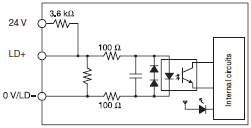 |
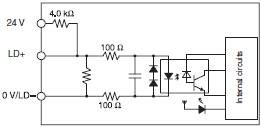 |
Interrupt Input and Quick-response Input Specifications (IN00 to IN03 and IN10 to IN13)
| Item | Specifications |
| ON response time | 30 μs max. |
| OFF response time | 150 μs max. |
| Response pulse |
 |
High-speed Counter Input Specifications (IN06 to IN09 and IN16 to IN19)
| 24-VDC input | Line driver input | |
|---|---|---|
| Set to 60 kHz | Phase-A/Phase-B encoder input, Single-phase
60-kHz pulse input with 50% duty ratio 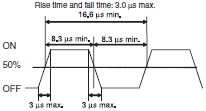 Phase-A/Phase-B encoder inputs, Differential phases, 30 kHz 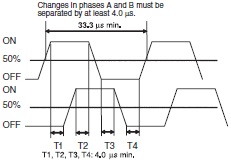 |
Encoder input phase A or B, single-phase 60-
kHz pulse input with 50% duty ratio  Phase-A/Phase-B encoder inputs, Differential phases, 30 kHz 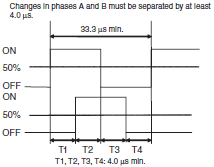 |
| Set to 100 kHz | Phase-A/Phase-B encoder input, Single-phase
100-kHz pulse input with 50% duty ratio 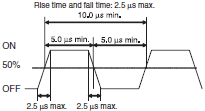 Phase-A/Phase-B encoder inputs, Differential phases, 50 kHz 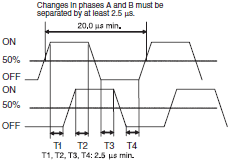 |
Single-phase 100-kHz pulse input with 50% duty
ratio  Differential-phase 50-kHz pulse input 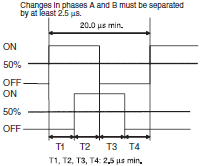 |
| Phase Z/
reset input |
Encoder input phase Z (IN02/IN03 or IN12/IN13)
 |
Encoder input phase Z (IN02/IN03 or IN12/IN13)
 |
Output Specifications (OUT00 to OUT05 and OUT10 to OUT15)
| Item | Specifications | |
| Output Specifications | Sinking- |
Sourcing- |
| Rated voltage | 5 to 24 VDC | |
| Allowable voltage range | 4. |
|
| Maximum switching current | 0. |
|
| Number of circuits | 6 outputs ( |
|
| Maximum inrush current | 3. |
2. |
| Leakage current | 0. |
|
| Residual voltage | 0. |
|
| ON response time | 0. |
|
| OFF response time | 0. |
|
| Fuse | None | |
| External supply power
( outputs) |
10. |
|
| Circuit configuration |
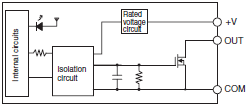 |
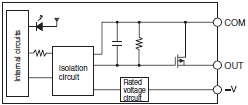 |
Pulse Outputs (OUT00 to OUT03 and OUT10 to OUT13)
| Item | Specifications | |
| Output Specifications | Sinking- |
Sourcing- |
| Rated voltage | 5 to 24 VDC | |
| Allowable voltage range | 4. |
|
| Maximum switching capacity | 30 mA | |
| Minimum switching capacity | 7 mA | |
| Maximum output frequency | 100 kHz | |
| Output waveform |
 |
 |
PWM Outputs (OUT04, OUT05, OUT14, and OUT15)
| Item | Specifications | |
| Output Specifications | Sinking- |
Sourcing- |
| Rated voltage | 5 to 24 VDC | |
| Allowable voltage range | 4. |
|
| Maximum switching capacity | 6. |
|
| Maximum output frequency | 32, |
|
| PWM output accuracy
( |
ON duty at 6. ON duty at 32. ( |
ON duty at 6. ON duty at 32. ( |
| Output waveform |
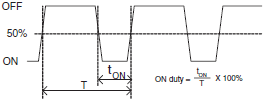 |
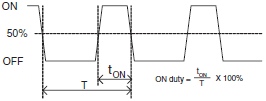 |
last update: October 1, 2024
 Product Category
Product Category
 Automation Systems
Automation Systems Programmable Controllers
Programmable Controllers CJ2
CJ2 CPU Units
CPU Units- CJ2M-CPU3[] / CPU1[] / MD21[]
 CJ2H-CPU6[]-EIP
CJ2H-CPU6[]-EIP CJ2H-CPU6[]
CJ2H-CPU6[]


